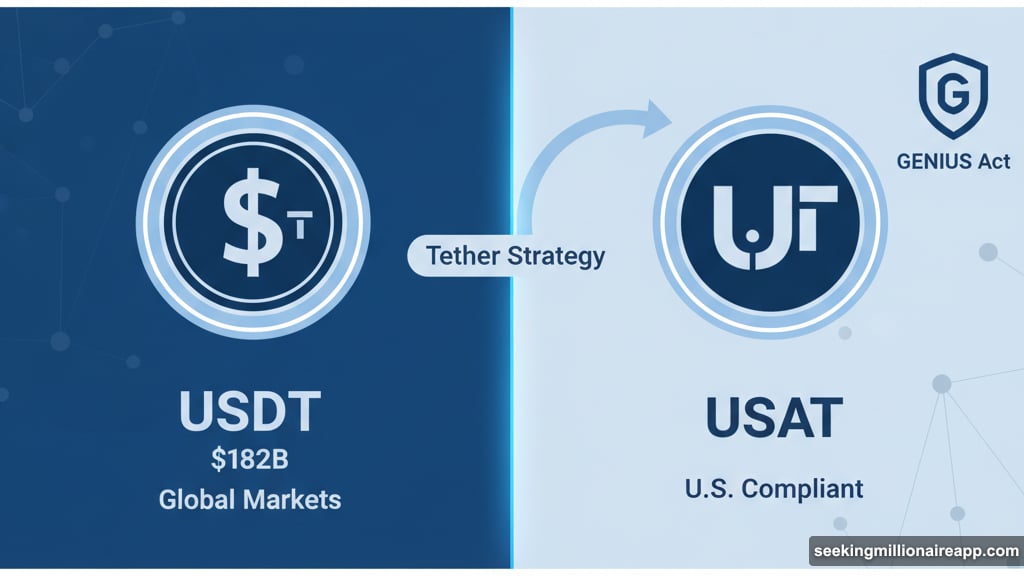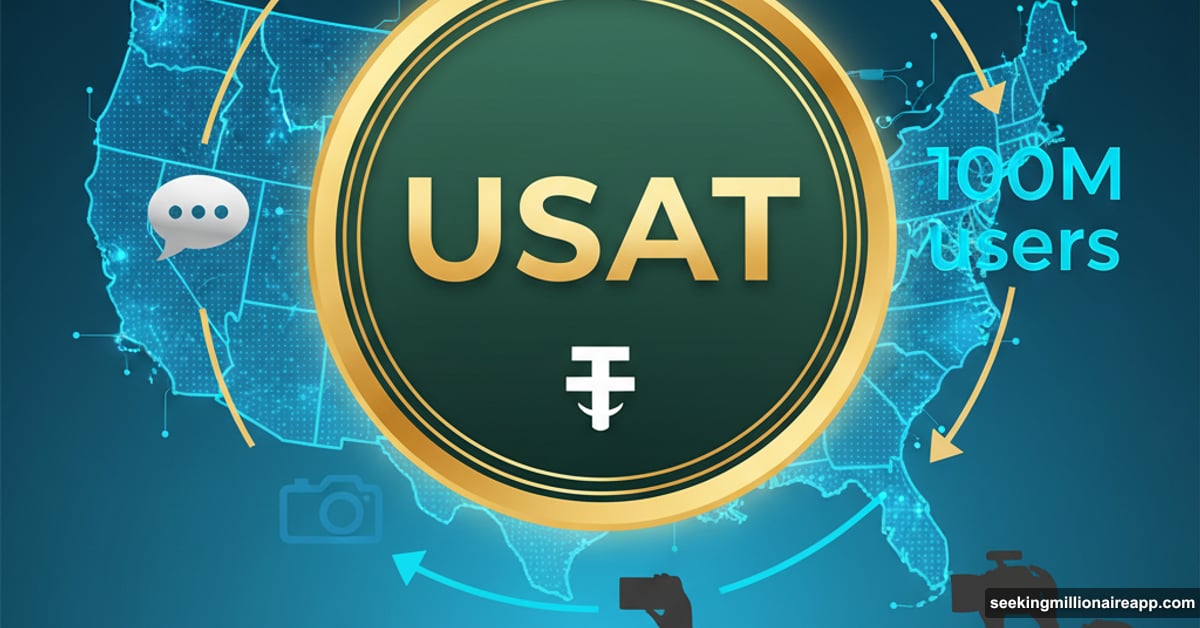Tether just announced its U.S. market invasion plan. The stablecoin giant wants 100 million Americans using its new USAT token by betting big on video platforms.
CEO Paolo Ardoino revealed the strategy during an interview in Lugano. His company already dropped $775 million into Rumble last year. Now they’re eyeing two or three more investments to hit that massive user target when USAT launches this December.
This isn’t just another stablecoin rollout. Tether is building something that could reshape how creators get paid in America.
Rumble Becomes the Secret Weapon
Tether’s investment in Rumble suddenly makes perfect sense. The video platform brings 51 million monthly active U.S. users to the table right away.
That’s a ready-made audience for USAT distribution. Plus, Rumble is launching its own crypto wallet later this year. So users can receive and spend stablecoins without downloading separate apps or learning complex processes.
Ardoino says the additional investments will add another 49 million potential users. He’s targeting social media companies and content platforms similar to Rumble. The focus stays squarely on the creator economy.
Why creators? Because they need fast, low-cost payment rails that traditional finance doesn’t provide well. PayPal takes cuts. Banks move slowly. Stablecoins solve both problems.
USAT Plays by U.S. Rules
The USAT token differs from Tether’s flagship USDT in one critical way. It’s designed specifically to comply with federal regulations.
The GENIUS Act set requirements for stablecoins operating in America. Tether America, a joint venture with regulated crypto bank Anchorage Digital, will issue USAT to meet those standards.
Meanwhile, USDT continues dominating globally with $182 billion in circulation. That’s up 33% since January. Circle’s USDC sits second at $72 billion, growing 70% this year.
But USDT faces regulatory scrutiny in the U.S. market. So Tether created a compliant alternative rather than trying to retrofit its existing token.
Smart move. They can maintain their offshore dominance while building a legitimate U.S. presence simultaneously.
Taking Aim at Competitors
Ardoino isn’t hiding his competitive intentions. He directly referenced companies that “tried to kill us in the first place.”
That likely means Circle and other regulated stablecoin issuers who positioned themselves as the “compliant” alternative to Tether. Now Tether is playing their game with USAT while maintaining USDT’s global lead.
The strategy gives Tether advantages on both fronts. USDT serves international markets where dollar access remains limited. USAT targets the massive U.S. market with regulatory cover.

Plus, the creator economy angle is clever. Instead of competing head-to-head with PayPal for merchant payments, Tether is carving out a niche where existing solutions underserve users.
Gold Token Surges Alongside Stablecoin Growth
Tether’s physical gold-backed token XAUT also exploded this year. The market size tripled to $2.2 billion as gold prices hit all-time highs.
Ardoino credits retail demand from Central and South America plus Asia. Everyday people are discovering they can own tokenized gold through their phones.
That’s significant. Tokenized precious metals seemed like a niche product. But when gold rallies, retail investors pile in. XAUT gives them exposure without dealing with physical storage or high minimum purchases.
Market makers also use XAUT increasingly. They can trade it on secondary markets with better spreads than CME futures. Nasdaq-listed Prestige Wealth recently raised $150 million specifically to buy Tether’s gold tokens.
So Tether isn’t just a stablecoin company anymore. They’re becoming a broader tokenized asset issuer.
The December Launch Timeline
Both USAT and Rumble’s crypto wallet launch in December. The timing suggests coordinated rollouts designed to maximize initial adoption.
Imagine this user experience. A creator posts videos on Rumble. Fans tip them directly in USAT stablecoins through Rumble’s integrated wallet. The creator spends those dollars anywhere that accepts stablecoins or converts to traditional currency.
No intermediaries. No 30% platform fees. No waiting days for payment processing.
That value proposition could genuinely attract millions of users if the execution is smooth. But big launches often hit technical snags. December gives Tether just weeks to get everything working perfectly.
What the Investments Actually Mean
Tether’s additional two or three investments remain unnamed. But Ardoino hinted at companies similar to Rumble in the content and social media space.
Think platforms with large U.S. user bases where creators earn money. Podcast apps. Streaming services. Maybe even Substack-style newsletter platforms.
Each investment brings another chunk of potential USAT users. Each platform becomes a distribution channel. Together they could genuinely reach that 100 million user target.
But here’s the catch. Just having access to 100 million users doesn’t mean 100 million active USAT holders. Tether needs compelling reasons for people to actually use the token regularly.
That’s where the creator payment angle matters. If USAT becomes the preferred way to tip creators or pay for content subscriptions, organic usage follows.
Regulatory Risk Still Lurks
Tether claims USAT complies with federal requirements. Anchorage Digital is a regulated entity. So far, so good.
But U.S. crypto regulation keeps evolving. What’s compliant today might face new scrutiny tomorrow. And Tether’s history of regulatory battles overseas could follow them home.
The company famously faced questions about USDT’s reserves for years before proving full backing. Regulators remember that history. They’ll likely examine USAT closely.
Plus, the GENIUS Act itself could change as lawmakers continue debating stablecoin legislation. Requirements might tighten. Tether would need to adapt quickly or risk losing its compliant status.
The Bigger Stablecoin War
This USAT launch is one battle in a much larger war. Stablecoins are becoming the payment rails for internet commerce. Whoever dominates that infrastructure wins enormous influence.
Circle positioned itself as the compliant, regulated option. PayPal launched PYUSD to defend its payment territory. Coinbase is building Base with integrated USDC. Now Tether is bringing $182 billion in global liquidity plus fresh U.S. compliance.
The winner probably won’t be determined by technology. All these tokens work similarly. Instead, distribution channels and regulatory positioning matter most.
Tether’s Rumble strategy targets distribution directly. If they can embed USAT into platforms where millions already spend time, they bypass the cold-start problem that kills most crypto adoption attempts.
That’s the real innovation here. Not the token itself but the distribution strategy.
My Take on the 100M Goal
Can Tether really reach 100 million Americans with USAT? The number sounds ambitious but isn’t crazy.
Rumble has 51 million U.S. monthly users. Add two or three platforms of similar size and you mathematically hit 100 million potential users. But “potential” differs massively from “active.”
Getting people to create wallets takes effort. Getting them to actually use stablecoins regularly takes even more. Tether needs frictionless onboarding and clear benefits that beat existing payment options.
The creator economy focus helps. Creators actively seek better monetization tools. Fans want to support creators directly. USAT could genuinely serve that need better than traditional options.
But December is soon. Very soon. Tether better have everything ready because first impressions matter enormously in consumer products.
If the launch goes smoothly and the creator use case resonates, USAT could genuinely become a major force in U.S. crypto payments. If it launches buggy or feels complicated, even Rumble’s user base won’t save it.
Watch for that December rollout. It’ll tell us whether Tether can translate international stablecoin dominance into U.S. market success.
